Consumer spending robust headed into the holiday season
by November 3, 2021 4:22 pm 443 views

The Apple Store at the Galleria in Dallas is busy with shoppers looking at the new iPhone 13 and other technology.
The impact of the pandemic on the nation’s economy will be a key factor in retail sales during the 2021 holiday season, but the National Retail Federation is confident in its forecast for record growth, according to Jack Kleinhenz, chief economist of the National Retail Federation.
“There are several factors coming together to have a major impact on the holiday outlook, but household fundamentals are a bright spot in the uncertain present,” Kleinhenz said in a media briefing on Tuesday (Nov. 2). “Consumers are in a very favorable position going into the last months of the year and are spending because they can.”
The trade group also on Tuesday expanded on the reasoning behind the robust growth predicted for this holiday between 8.5% and 10.5% over a year ago. Even at the low end of the forecast of $843.4 billion in sales for November through December, the growth will eclipse last year’s record $777.3 billion in holiday sales, Kleinhenz said.
Holiday sales forecast by NRF excludes automobile dealers, fueling stations and restaurants and focuses on core retail including online sales. NRF predicts online sales will rise between 11% and 15% and total between $218.3 billion and $226.2 billion this holiday season. NRF’s forecast model looks at consumer spending habits along with disposable income, past retail sales, employment, wages, weather, energy prices and other variables. Despite “complex mechanics and forces at work,” the outlook is favorable for strong retail sales growth this holiday season, Kleinhenz said.
He said the pandemic raises questions of whether COVID-19 cases will continue to trend downward and whether this will increase consumer confidence to spur on spending. Kleinhenz said the question remains about where consumers will spend – will it continue to be on retail goods or will spending start to shift to services if they become more comfortable traveling, going out to restaurants or attending sports and entertainment events?
Kleinhenz said spending has continued at a brisk pace throughout 2021, up 14.5% year-over-year for the first nine months, and has returned to pre-pandemic levels for many retail categories.
“While some individuals who lost jobs last year still face financial difficulty, data tracked by Harvard University shows spending by low-income consumers was up 22.3% at the end of September compared with pre-pandemic January 2020. The number appears to reflect enhanced unemployment benefits and other stimulus money such as the new child tax credit,” Kleinhenz said.
He and senior economist Mark Vinter at Wells Fargo Securities believe there is a savings buffer of about $2.5 trillion consumers accumulated during the pandemic by staying at home, eating at home and foregoing travel. Kleinhenz said income is also growing in the form of more jobs, more hours and higher wages reflecting businesses’ competition for workers amid the U.S. labor shortage. He said record household wealth has boosted consumer confidence, the backbone of more spending this year.
Vinter said economic data last week consisted of a series of highs and lows, as the mixture of lingering supply chain issues, rising prices and still-strong consumer demand continues to make its way into economic data. He said existing home sales rose 7% last week and new home sales were up 14%. He said this healthy rise looks like a second wind for the housing sector that had been slowing in recent months.
Also a bright spot was the first gain in consumer confidence in three months last week after months of confidence missing expectations. Vinter said the increase was due to renewed optimism around consumers’ present situations and expectations for the future, which bumped the index reading four points to 113.8. Consumers’ positive views on the labor market contributed to the rise in confidence, as did the recent decline in COVID cases.
Vinter said the data show more consumers expressed a willingness to pack the bags for vacation and hit the stores during holiday season. He said 47% of consumers polled by Wells Fargo are planning a vacation in the next six months. He said consumers also signaled plans to purchase large appliances, vehicles and homes in the next six months. Vinter said consumer spending rose 0.6% in September, led by an uptick in sales among the service industry. He reports personal spending is already 3% above its pre-pandemic level.
Kleinhenz also said the strong growth in income and “stockpiled savings” should help spending overcome inflation that has been driven by consumer demand and supply chain disruptions. The challenge when – and if – sales begin to fall will be whether the drop is caused by weaker demand or reduced product availability. He warns higher gasoline prices and higher energy costs for home heating will likely divert some money that could go to retail sales.
